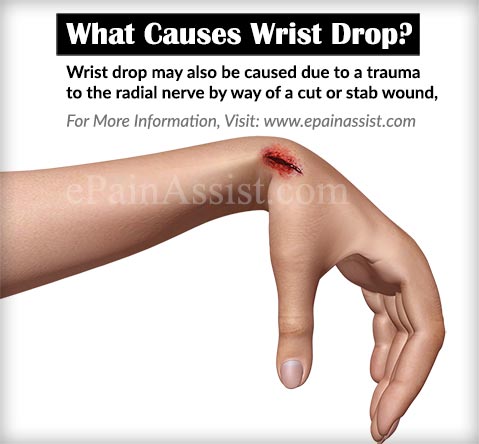What is Wrist Drop?
Wrist Drop is a pathological condition in which there is an injury to the radial nerve resulting in impaired nerve function causing radial nerve palsy. Functionally speaking, the function of the radial nerve is to carry signals from the brain to the hand. When there is an injury to this nerve then the patient may experience quite a few symptoms which include numbness in the wrist, back of the hand, and forearm. The patient may also find it difficult to use the hand normally in day to day activities like gripping and grasping objects. There may also be weakness experienced of the hands. The patient may also find it difficult to bend the wrist backwards. The main cause of a Wrist Drop is overuse of the hands and wrist. This overuse leading to wrist drop may be seen in people who are involved with heavy lifting along with repetitive gripping and grasping. Athletes who play sports like tennis or badminton may also get this injury as they use their wrist repetitively for a number of years. Wrist drop may also be caused due to injuries of wrist joint or forearm resulting in radial nerve injury. There have also been some cases where no known cause has been identified for a Wrist Drop.

What Causes Wrist Drop?
As stated above, the main cause of a Wrist Drop is overuse of the wrist whether it be with occupation or sports. Wrist drop may also be caused due to a trauma to the radial nerve by way of a cut or stab wound, or if a person suffers a gunshot wound to the wrist affecting directly the radial nerve. Another cause of Wrist Drop is radial nerve damage from soft tissue injury over wrist and forearm resulting in soft tissue swelling and compartmental syndrome. Compartmental syndrome is caused by spread of blood clots within wrist and forearm as well as edematous swelling of muscles and tendon. The blood clots and soft tissue swelling causes increased pressure within the wrist and forearm, which result in compression of radial nerve as well as stoppage of its blood supply. If a person falls asleep with a hand hanging over a couch or a chair then also there is a chance of injuring of the radial nerve because of overstretching of radial nerve. Fractures of the elbow joint or the upper arm (humerus bone) can also cause radial nerve injury and Wrist Drop. Wearing tight bracelets can also cause injury to the radial nerve resulting in a Wrist Drop. In some cases, a Wrist Drop may develop without any known cause.

What are the Symptoms of Wrist Drop?
Some of the symptoms of Wrist Drop include:
- Numbness behind the hand and forearm
- Symptoms of weakness of the wrist with difficulty in using the wrist normally in day to day activities and inability of the patient to bend the wrist backwards or straighten the thumb and fingers may be observed.
- A person suffering from Wrist Drop may also experience symptoms of persistent pain in the forearm or elbow

How is Wrist Drop Diagnosed?
The best way to diagnose an injured radial nerve which is the case in Wrist Drop is by conducting an EMG and nerve conduction study of the wrist. This study will identify as to whether signals are passing through from the brain to the hands through the nerves normally or not. Apart from this, radiological studies can also be done in the form of an MRI scan of the wrist to see if there is any nerve compression or impingement resulting in development of Wrist Drop.
What is the Treatment for Wrist Drop?
All patients following any signs of wrist drop must see primary care physician or specialist before trying any conservative treatment. Treatment for a Wrist Drop solely depends on the cause of the condition. In mild cases of Wrist Drop treatment advised is 2 to 4 weeks of rest and restriction of wrist joint movement. Restriction is achieved with use of splints. Some physical therapy exercises may be enough to maintain the tone and power of hand, forearm and upper arm muscles. In moderate to severe cases of Wrist Drop are treated with antibiotics or surgery depending on cause of wrist drop. The surgical procedure is needed to treat wrist joint fracture, dislocation, compartmental syndrome and soft tissue injury. The radial nerve surgery is performed to anastomose cut radial nerve or free compress radial nerve from surrounding tissue. Post-surgery, the hand affected with wrist drop may remain immobilized for a 6 to 8 weeks to allow the wounds to heal. After appropriate time has elapsed allowing the wound to heal, then the patient may undergo physical therapy focusing on strength and range of motion. Gradual return to work may commence after about 15-20 weeks since surgery. In case if wrist drop does not need surgical treatment or antibiotics then following home remedies can be tried:
- Resting the wrist until the patient feels return of strength and sensation
- Use of splint or sling can be a vital part of treatment for Wrist Drop.
- The patient needs to avoid positions that may put pressure on the wrist or underarm.
- Avoiding repetitive motions of the wrist will also be helpful.
- Wrist Drop https://www.ncbi.nlm.nih.gov/books/NBK532993/
- Clinical Features of Wrist Drop Caused by Compressive Radial Neuropathy and Its Anatomical Considerations https://www.ncbi.nlm.nih.gov/pmc/articles/PMC4024814/
- Wrist Drop – sciencedirect https://www.sciencedirect.com/topics/medicine-and-dentistry/wrist-drop
Also Read:
